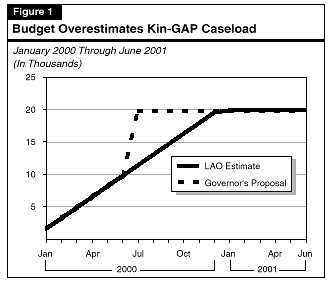
The Kin-GAP (Kinship Guardianship Assistance Payment) Program, authorized by Chapter 1055, Statutes of 1998 (SB 1901, McPherson) became effective January 1, 2000. Under the program, a relative caregiver is eligible for a Kin-GAP grant if he or she assumes legal guardianship of a foster child. To qualify, the child must have been in foster care placement with the relative caregiver for over 12 months. Once enrolled in Kin-GAP, the guardian receives a grant, paid at 100 percent of the basic foster care (foster family home) rate. The program is supported by the state General Fund, federal Temporary Assistance for Needy Families (TANF) block grant funds, and county funds.
Enrollment in Kin-GAP Program Not Automatic. Movement to Kin-GAP is not automatic. In order for it to occur, the court must terminate court dependency of the child and the caregiver must assume guardianship of the child.
We recommend a General Fund reduction of $443,000 because the Kinship Guardianship Assistance Payment Program caseload is overestimated. (Reduce Item 5180-101-0001 by $1,841,000, increase Item 5180-141-0001 by $273,000, and reduce Item 5180-151-0001 by $1,125,000.)
The Governor's budget proposes $109 million ($28 million General Fund) for the Kin-GAP Program in 2000-01. In addition, the budget reflects savings ($24 million General Fund) to the foster care and child welfare services programs, associated with termination of juvenile dependency for those children placed in the Kin-GAP Program.
The budget estimates that the Kin-GAP caseload will begin with 1,629 cases in January 2000 and increase by about 1,630 cases each month in the current year, ending with a caseload of 9,783 in June of 2000. The budget projects that the caseload will more than double (to 19,880 cases) in the one-month interval from June to July of 2000 and remain at this "full-implementation" level throughout 2000-01. When comparing the average monthly caseload in 2000-01 to the average for the six months covered in the current year, the budget projects a 248 percent increase.
The department has provided no policy rationale for the immediate doubling of caseload at the beginning of 2000-01. For this reason, in our caseload projection we maintain the administration's current-year phase-in of 1,630 cases per month, but we assume a continuation of that monthly trend until full implementation (19,880) is reached in January 2001 (See Figure 1). This would result in an increase of 210 percent over the six-month average in 1999-00, reflecting the ramp-up of the program, but less than the increase assumed in the budget. Consequently, we recommend that the budget reflect more steady caseload projections, for a net General Fund savings of $443,000 in 2000-01.
